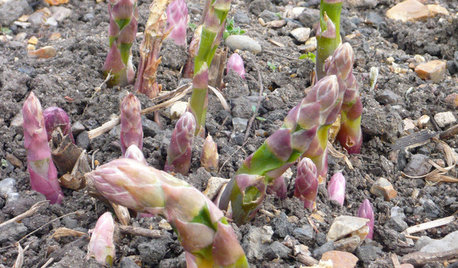If you had to live off of what you grow?
We are seriously considering a project where we will eat only those things we can grow ourselves and things we can trade for. A couple of families will be involved and only one family at a time will be living-off-the-land. Then, another family will do the same while we go back to the "modern" lifestyle. So, at any given time, one of our families will be off-the-grid so to speak.
This will make it possible for the gardens to be kept smaller and, still have the benefit of more people taking care of the gardens.
For many years I grew a vegetable garden but, I have not gardened for the past few years.
Most of what I grew was to provide myself with vegetables that I could grow cheaper or, those that were much better-tasting when grown at home. Here, with this project we are more concerned with the most nutrition for the buck.
If you had to grow EVERYTHING YOU ATE, what would you have growing in order to feed a group in ages from babies to the elderly? I am not so much concerned with "Heirloom", as I am with "open pollinated". Of course, saving seed is gonna be important.
Here in SE Louisiana we can have a crop growing the entire year. Very rarely do we even get a hard freeze. I have had excellent success growing many vegetables through winter without any extra steps being taken. So, with a little extra effort, we should be able to produce an impressive winter-crop.
We are hoping to be able to share these growing techniques with folks in Mexico, Central America and, South America. The growing seasons in the areas we will be working have long growing seasons also.
Please give the "variety" of the particular vegetable you reccomend.
Comments (35)
fusion_power
13 years agolast modified: 9 years agoPotato - get 400 (about 50 pounds) sets of Kennebec.
Corn - 2 pounds each, Stowell's Evergreen and Cherokee Squaw
Bean - 2 pounds of Rattlesnake pole bean
squash - 1 ounce of yellow crookneck
Cucumber - 1 ounce of Japanese Climbing
Tomato - 200 seed each of Box Car Willie and Heidi
Pepper - 100 seed each Cayenne and Chapeau de Frade hot and Orange Bell sweet
Multiplier Onion - 200 sets, you can find these from local gardeners
Radish - 4 ounces, any of the white tip red type radishes
Turnip - 1/4 pound Purple Top White Globe
Cabbage - 2 ounces, Late Flat Dutch
Lettuce - 1/4 ounce, Jericho or Nevada
Cowpeas - 2 pounds, White Whipporwill
Okra - 1/8 pound, Granny Franklin or Clemson Spineless
Watermelon - 200 seed, Ledmon
You have to think in terms of what you are willing to work to grow. It will take about an acre to grow enough of the above to feed an average family of 4.
DarJones
Macmex
13 years agolast modified: 9 years agoBigoledude,
I lived and taught gardening and small animal husbandry in Central Mexico for 8 1/2 or 14 years, depending on how one counts. There are some things which will transfer, perhaps more so, if you try to use them on coastal areas, at low altitude. But let me tell you up front, that latitude and altitude combine to make for a whole different world for gardening. Whatever you learn in LA, you'll have to prove in Central America, probably over a period of a couple of growing seasons, in order to be sure that it's "a winner" there as well.
To DarJones' list, I'd be sure to add sweet potatoes. Use the locally available ones, if in Central America, as they'll easily outproduce U.S.A. imports by double.
I'd also add squash. Again, in Mexico, at any rate, I could coddle my favorites into producing. But the local "creollo" land race would always outshine my favorites. I suppose I'd say the same about corn and beans.
George
Tahlequah, OKfarmfreedom
13 years agolast modified: 9 years agoadd spinch , garlic , spices, the winged bean,jicama,
Macmex
13 years agolast modified: 9 years agoThere is SO MUCH to consider when drastically changing latitude.
"Multiplier Onion - 200 sets, you can find these from local gardeners"
It took me almost 10 years to find a multiplier onion which would bulb at 20 degrees latitude (roughly Mexico City). The only one I could find, in either the US or Mexico, was a shallot, grown from seed, called Atlas.
We still grow Quintonil, a semi-domesticated vegetable amaranth from the Mexican state of Puebla. It's cooked a lot like Swiss Chard. Anyway, wherever you go, be sure to learn from those folk too. They will likely grow things you have hardly considered.
George
sage721
13 years agolast modified: 9 years agoI would bend towards more sweet potato as well, but that's just a personal taste thing. Can't recommend any varieties, because up here in zone 6, the options are kinda limited as to what I can get to fully form up. Kent. Wonder pole beans are a old stand by, good producer, and dry pretty well up here. Box car willie toms split for me when we get heavy rains, may want to look into a roma type. Just some non specific thoughts from the slightly frozen north. Best of luck in you and your families. I admire you for embarking on such ambitions adventure.
dorisl
13 years agolast modified: 9 years agoHi,
Animal, Vegetable, Miracle
by Barbara Kingsolver,If you haven't read this book, you should see if your library has it. They did exactly what you are talking about. Its a good read!!!
carolynp
13 years agolast modified: 9 years agoI would recommend you read up on square foot gardening. Also, Steve Solomon wrote a book called Gardening When It Counts. Those two books will give you a great idea of what you need to decide on what to grow. Growing 7 thousand cabbages won't do you any good if no one in your family or the other families will eat cabbage. I dig the list that fusion put together for you, but it wouldn't work for our family. If we were going to try to live off our our plot of land, my first purchase would be some chickens. They'll eat your bugs and give you eggs and free compost. Our area just made it legal to own chickens in the city. I bring this up to point out that you might have a bigger task than you realize. You don't need just a list of seeds, you need to figure out the scope of the total project. Sorry to be so wordy.
catboy
13 years agolast modified: 9 years agoI'm an omnivore, so in addition to chickens, I'd have to add pigs & cows - and someone to butcher 'em for me when the time comes
rodger
13 years agolast modified: 9 years ago"I'm an omnivore, so in addition to chickens, I'd have to add pigs & cows - and someone to butcher 'em for me when the time comes"
Why some else to butcher. Butcher yourself. We raise our own hogs and chickens and have always done things ourself. Just cooked up some side meat that I smoked last week from a hog we butchered at thanksgiving and it was pure heaven The hams still have a few more weeks till there are ready to smoke.We make our own sausage, cure and smoke the hams and sides, cook out the lard and cracklings and make soap with last years left over lard. Chickens provide eggs fresh meat and older birds chicken stock. I would leave out the cow too much space and feed/forage to raise and requires 2-3years before ready and large cooler to hang the meat in while it drains.Hogs take 5-6months to get 300#plus. Rodger
cindy_eatonton
13 years agolast modified: 9 years agoI would second dorisl's recommendation on "Animal, Vegetable, Miracle" - it's about a modern family doing as you're describing - eating locally whether from their garden or from local farmer produce. They're in Tennessee (I think). But fascinating to see what issues come along and to plan for them.
bigoledude
Original Author13 years agolast modified: 9 years agoWe are surely sharing our results with our people working in the other countries. We have always considered the locally grown varieties first. The workers that preceded us many many years ago quickly realized that some varieties just will not perform in differing locations, regardless of how spectacular they perform in your home area.
Most of what we offer is varieties being grown in similar locations/elevations/latitudes that produce well. There are also techniches that aid these folks that they'd never used, that have been in practice for generations elsewhere.
We also are recording our results for folks who are considering living "off the grid".
We have certainly considered meat production. There is not nearly enough land here in our area to raise cattle.
We have a thriving brace of Muscovy ducks. Our Red Star chickens are gonna arrive this month.
We live in SE Louisiana and, are smack up-against a huge brackish marsh. We can harvest a very ample supply of fish, game and shellfish (shrimp, crabs)
The debate continues as to whether or not to get rabbits. We have found that the Californian-New Zealand crossed rabbits produce nearly a pound of meat in exchange for every pound fed. Rabbits will require cages, waterers and nesting boxes etc... We will need to compile a list of what we can grow that will provide the proper diet for healthy rabbits that gain weight quickly. Preferably, of course, foods that they can SHARE WITH US.
The ducks and chickens can/will forage for much of their diet. The muscovies are the best moms and hatch/raise nearly every duckling to maturity! Hope the chickens do as well.
Does anyone have favorite breeds of chickens that hatch and raise their chicks better than most?
Macmex
13 years agolast modified: 9 years agoI think you're barking up "the right tree" with the Muscovies. We have them and they are fantastic meat producers for all the reasons you mentioned. We have two heritage breeds of chicken. One is the American Buckeye and the other the Kraienkoppe. The Buckeye makes a lot better carcass and lays perhaps a little better. But it also consumes more feed. The Kraienkoppe is a true "survivor chicken." Both breeds hatch and raise their little ones. But the Kraienkoppe is by far more tenacious about it.
Old English Games are on pare with Krainkoppes. Though, their carcass is smaller.
There are many good breeds out there. Egyptian Fayoumis are great layers and foragers, though they don't tend to hatch their own. Still, they are really good, especially in a warm environment.
The American Dominique is a great all purpose bird, as is the Dorking.
A good Rock, like "Barred Rock," would probably be extremely practical. You might get a mix and then see which you like best. Just be ready to be disciplined and reduce down to one or two breeds if you intend to maintain your stock.
Given your interests, you would probably appreciate Carol Deppe's book, which I linked below.
George
Tahlequah, OKHere is a link that might be useful: review on
junkmanme
13 years agolast modified: 9 years agoI think you are considering the right rabbits.
Regarding chickens: Personally I would go with 3 breeds: The Rocks, such as "Barred Rock" great layers and good meat-birds also. Leghorns which are smaller...but the BEST egg producers per # of feed, and Buff Orpingtons, which are great egg layers and also a good meat-bird AND are very often "broody" so they can hatch and raise chicks from the other two breeds.
With those 3 Breeds of Chicken...you've got your "bases-covered".
Vegetables: I'd definitely recommend some mildly HOT peppers such as Jalapenos, and Anaheims and.... pinto beans.
Around here..(in New Mexico)...I can buy them much cheaper than use the space for growing them...but I grow them anyway.(I MUST HAVE my chiles!) In Mexico, you will find varieties of peppers and beans that will suffice...but I, personally would also grow these. And Bell Peppers (or Anchos) and a long season Sweet Corn such as the old heirloom "Golden Bantam".
A LOT depends on HOW MUCH GARDEN AREA you will be using.
Some plants, such as corn, are gonna take up a lot of area.
I would also include a Zucchini Squash...mostly because it is so PROLIFIC !just my 2 pesos worth,
-Junkmanme-fusion_power
13 years agolast modified: 9 years agoThe best "live off the land" chickens are usually lightweight games such as the Old English. In the past, I kept a game rooster with americauna hens and raised crossbred chickens. They are arguably the most adaptable and survivable chickens that I have owned. That is from about 30 breeds I've grown over the years.
I saw one significant concern in your statement about rabbits. They ONLY return a pound of meat for a pound of feed if the feed is highly protein dense. From your description, you want to be able to feed them whatever is available. That infers lesser quality and therefore less meat produced. I would expect your rabbits to eat more and gain weight slower than you would hope. For background, I helped my FIL with a rabbit operation for 2 years. We saw all the ins and outs of growing rabbits for meat. Did I mention that rabbits need nest boxes? Or that keeping productive females can be a challenge?
DarJones
tracydr
13 years agolast modified: 9 years agoIf the chickens will be foraging, stay away from lighter colors. All of my lighter colors turned into coyote and hawk bait. The old English were by far my hardiest, although I never had the americauna.
I had some old English bantams that made great mothers, I kept them around just to mother all my other chicks.
Another very good variety in the heat which lays and is fairly heavy is the naked neck. Terribly ugly but prolific, heavy, great layers and very hardy.tracydr
13 years agolast modified: 9 years agoI would be sure to grow plenty of okra, sweet potatoes and eggplant, since they do well in the heat. Also, lots of peppers.
In my visits to Central and South America, they eat a lot of meals with black beans and peppers so I would look into each country and consider the local cuisine. My peppers and eggplants can be overwintered and produce nearly year round.
Swiss chard as it seems to grow no matter what and produces lots of high nutrition food. It's a perennial for me in AZ. Mustard, collard and turnip greens will produce like crazy in cooler weather.
Garlic, winter squash,bigoledude
Original Author13 years agolast modified: 9 years agoHey DarJones
The Ameracaunas hens bred by an Old English Rooster produced "the most adaptable and survivable chickens" of all you raised? Were the Old English OK around children?
It makes sense what you say about the "super-protein" rabbit food compared to what they'll be eating here. But, what was the challenge in keeping productive females? Did their production fall-off as they aged? Did they suffer from health problems?
tracydr
Ditto on other peppers and eggplants. We have NOT had very good success with Swiss Chard during the heat of summer. I've read where a shade cloth helps. We're trying it out this summer. Everyone really loves the Chard. It would be great if we could get it producing all summer.
As far as bell peppers go, we have had no success the last couple of years. I'm talkin total crop failure!
It would take some lousy production numbers for me to resort to the "Naked Necks". Can't an old guy have his chickens and they be pretty too? Look at DarJones recommendation. Gorgeous Ameracauna chickens and their even prettier eggs. And, nothing is more handsome than an Old English rooster! Those crosses "were the most adaptable and survivable chickens that he ever owned". See!!
I watched an Osprey catch and eat a coot over the marsh directly behind my house today. Twenty minutes later a Redtail hawk snatched a White Egret. She didn't even see it coming! It is obvious that I am going to need some wary chickens if they're gonna make it here. Or, I'm just gonna have to keep them penned up.
Macmex
13 years agolast modified: 9 years agoI headed up a rabbitry program in a Bible Institute in Mexico and we kept about 10 does most of the time. Their production did not fall off with age. But when they "hit their limit" age wise, there was seldom any warning. They would simply stop being able to carry a litter full term and drop them prematurely on the wire. So, if one has an outstanding doe, it is a good idea to save a few daughters from her, sooner than later. Productive does can "go down" after only a year and a half of constant production. Some go quite a bit longer. But one never knows.
It is of utmost importance that young does not be allowed to get fat before breeding. If they become overweight before their first litter, the fat can obstruct the fallopian tubes and they may never be able to conceive.
There are two basic ways to feed rabbits. In Spanish they spoke of "intensive" vs. "extensive." I'm kind of transliterating into English, so I'm not sure if the terms pass directly over into English usage. Anyway, intensive is what most people do by feeding straight rabbit pellits. That is a balanced diet and works quite well. However, it can cut down on the profit in some situations. Also, there are places that fresh pellets are very hard, if not impossible to obtain.
To feed extensively one uses materials on hand and supplies both forage and grain. Forage can be in the form of alfalfa, grass, curly dock or even banana leaves. There are many leaves which will do. But one has to experiment to find them. Grain can be fed in the form of most any grain such as oats or whole kernel corn. In Mexico a favorite form of "grain," for this kind of diet, was stale tortillas. The rabbits loved them and grew very well eating them... as long as they also had forage.
When done well we found that rabbits raised extensively grew pretty much as well as those raised intensively. But sometimes we couldn't find optimal materials and then they would grow more slowly. In difficult situations there are times that grain sources are hard to come by. Then, one can go much more heavy on the forage. Litters may be smaller and it may take much longer to get the young ones up to butchering size. But it still works well enough to be worthwhile.
Bigoledude, we free range our birds and I've found that most of the time they're alright once they are past "lunch box size" for a redtail hawk. By that, I mean they have to be too large to be easily carried away. I keep our pullets and poults (young turkeys) under cover until they are nearly two pounds in weight. Usually this occurs when they no longer have any downy fluff on their heads. But sometimes it takes even longer. The person who mentioned darker colored birds for free range is right on. And, yes, some breeds are more predator resistant than others.
Nothing is completely fool proof. For some weeks, this winter, we had an eagle taking full grown chickens. There was nothing we could do about it. Fortunately he moved on after a while.
George
MyPatriotSupply
13 years agolast modified: 9 years agoMyPatriotSupply.com would be interested in partially sponsoring this project. Please email mparker@mypatriotsupply.com and we can discuss this. We support whole-heartedly what you are trying to accomplish.
nutsaboutflowers
13 years agolast modified: 9 years agoI don't think anyone has mentioned lentils.
I don't know their requirements for growing, but you could live with less meat if you were to grow lentils.
Please keep us up to date on your awesome plan.
Tiffany, purpleinopp Z8b Opp, AL
12 years agoThe previous contributor was thinking similar thoughts to me. I would want some type of sugar beets or sugar cane.
HONEY! You need lots of busy bees, anyway.
Some type of wheat for making pasta, bread, desserts.
Rice.
Peanuts. Good for the oil, the nuts, peanut butter. Tree nuts.
Nobody has mentioned any fruits or berries.
Basic herbs like basil, cilantro, rosemary... and a 3rd vote for garlic!
Don't they also grow coffee & cocoa in those regions?
Trishcuit
12 years agolast modified: 9 years agoI am thinking about things like letting segments of land lie fallow once every so many years, with cover crops put in to replace nutrients and prevent soil erosion. I also found a good site on crop rotation.
Here is a link that might be useful: vegetable crop rotation.
zzackey
12 years agolast modified: 9 years agoI love your idea. We had rabbits as pets. They are prone to alot of diseases and ear mites. We had to give them ear drops. Not a fun thing. They probably need shots too.
zzackey
12 years agolast modified: 9 years agoI agree with the crop rotation. I just found out it goes by plant families, not just the plant. Tomatoes, potatoes, petunias and tobacco are all in the same family. I want to try letting the soil rest also. We haven't done it yet. We can grow something year round here and our garden is tiny. We feed our chickens fresh collards, swiss chard and kale leaves plus we give them (free) whole grain bread. We have 2 Rhode Island Reds. They were free range until the neighbors dog killed 6 of them. They love to eat weeds! I would raise a few turkeys because I love their eggs and of course their meat. Also I would raise English peas, tomatoes, especially cherries, sweet potatoes, Irish potatoes, lettuce, radishes, lots of herbs, broccoli, spinach, cat food ( just checking to see if you are still with me!), lima and bush beans, watermelons, yellow squash, zucchini, butternut squash, carrots and celery and garlic. Llamas for their wool and cows for their beef. Thanks for sparking my imagination! We would love to have extra produce to sell or give away. Our varieties change each year. We haven't gardened enough to have favorites.
vtguitargirl
12 years agolast modified: 9 years agoIf I had to live off what I grow, (who knows, someday I might) I'd be in trouble. I'd need to grow much larger crops of things I already grow. And I'd have to work on preserving & storing food.
Here's what i already grow:
-Potatoes (lots of Kennebecs, plus a few others for variety)
-Dry Beans
-Soup Peas
-Winter Squash (Butternut, Delicata, and another storage variety)
-Greens: chard, spinach, kale
-Root Veggies: carrots, beets
-Alliums: Garlic, onions
Tomatoes: San Marzano, Prudens Purple, Jaune Flamme, Cherry
Other: cukes, zucchini, English peas, green beans, asparagusFruits & Veggies that would be new:
*Painted Mountain Flour Corn
*Berries: strawberries, raspberries, blueberries
*Fruit Trees: Apples & Pears
*Hazelnuts
*Herbs
*MushroomsI would definitely have chickens for eggs. Dairy, meat and flour are items produced locally, so I would trade for them.
DemonsHollowAsylum
12 years agolast modified: 9 years agoI am a new member to gw and hope I am not intruding here but Wow!
We are attempting this exact same thing right now.
We moved to 82 acres of sand and sage brush just over a year ago and are starting with absolutly nothing but what we brought with us and can provide or build on our own. We are 38 miles from the edge of town and we are 100 percent off grid.
We have no address, so no fire , police, or medical services of any kind out here.
When we moved here our plans were to gradually build up to a self sustaining life style over a period of a few years. We had a savings and job options all lined up. Instaed, the economy tanked and I lost any hope of working due to my health.We were kind of forced to decide on the spot if we realy wanted to do this or if we were going to go back to the city. We decide this realy is what we want to do and have been sticking to it.
We haul water, we are building solar panels, have a very small geni for night time power and heat with scavaenged wood and use straw for insulation for both us and the animals. It took a full year for my partner to find any kind of work at all we lived off of saving and my tiny disability income until then and now most of his pay goes for fuel to get to work(79 miles round trip every day) .
I was not able to get a pair of goats until Aug 25th of last year. We still need two more does so that we can keep a clean heard of 3-5 goats going at all times for both meat and milk. We have chickens ( the first thing we put out here, Reds, Amercanas,Siklies, and Bantoms) as well as Ducks and Pheasant.
We plan on Turkeys and Geese this year. We also plan on rabbits in the future ( the new zelands )but have a large wild population to hunt for now. We will be saving for American Guinea Hogs and Irish Dexter Cattle. If we must, we will do a Dexter / Jersy cross for the cattle.We only want the smaller heiratige breads of the larger livestock since they are much nicer to the land ( I can comfortably range 3-5 dexters on the same amount of land as 1 of the standard breads of cattle and that 3-5 animals is all we will need ) and they can comfortably handle our major temp swings with out health issues.
I only managed a small experimental bed last year. It was to see if I could grow all of the things that the folks here has major dificulty with since they are some of the mainstays in most home gardens (tomatoes , peppers, beans, greens, and mushrooms ). With a lot of creative gardening , it worked. So this year will be my first real garden attempt. A large percentage of what others have posted is on our list of things to plant or grow.
This is not an all inclusive list but we have also added things Quinoa , flax , sorgums, sunchokes, sunflowwers, barley, oats, rye, buck wheat, soybeans, alfalfa, millet, wheat and clover ( because all of these they are good for both human and animal consumption). Most of these things can be grow together because they devolpe and mature at different times, many are symbiotic relationship plants
( think 3 sisters planting,like corn, beans and squash in the same bed), and they also build and maintaining the soil. We have not yet aquired most of these but hope to soon.They provide food crops and fodder crops at different stages so the production is double duty. With carefull and selective harvesting and seed saving we can set aside next years crop of some of the anuals like the buck wheat.
We have plans on a small orchard and I received a gift of a few nut trees for birthday ( 2 hazel nuts a pecan and an almond) and they should arive in june. We will also try to take advantage of the native plants to incourage the continued diversity of wild life we have out here.
If the Fox, Cyotes ,hawks,eagles, mountain lions , badgers and other bigger preditor types have an ample food sources, our animals are less attractive to them. We also get better polination , and bug controls.
I am an experianced gardener but not in this zone 5 and with these kind of temp swings ( We are alpine high desert with -5 to -15 in the winter , 100 plus regularly in the summer and a last frost date of june 10 ).
I can tell you it will be a challenge to everything you think you know.So, Thank you,
Your efforts do not just benefit those you seek to help but also some of us at home.I wish you the best of luck with your experiment and will follow your post for any lessons you may be able pass on.
veggiemoonfarm
12 years agolast modified: 9 years agoMy fiance and myself just started a sustainable organic (partially hydroponic) farm in S Iowa on 20 acres, as of last summer. We are in our early 20s, vegetarian and plan to live off this year's crop of veg, grains, beans & legumes, and fruit. we're going with wind energy and generators, compost, the goal is being fully sustainable. i gotta chime in on the chicken talk- we free range our flock of 6 roosters and 30 hens, of 5 different breeds. I second the notion of not getting light colored birds due to predators. we plan on getting a few more extra-rare heritage layer breeds in order to try to preserve them.
the Veggies we are growing are all OP mostly heirlooms with the intention to preserve the seed and learn.
This year we're going with:
bean, bush � koronis purple 25, baby black lentil, fin de bagnol, Tankuro Soybean, Aoyu Edamame
bean pole- garden of eden , california blackeye #5 cowpea, red noodle yard long, Thai Purple Podded Yard Long
broccoli- Rapini
Brussels sprouts � Long Island Improved, Falstaff
cabbage - tete noir, de Boeuf des Vertus, wong bok
carrot - parisian
cauliflower - romanesco
celery � giant red
chicory- grumolo rossa di verona, Pan di Zucchero
collard - Cascade Glaze
corn � hopi blue, cherokee white eagle, painted hills, penn. dutch butter flavored
endive - witloof
lettuce - marvel 4 saison, little gem romaine, oakleaf, Les Oreilles du Diable, white boston, vert de cambrai mache, punterelle , watercress, Ice-Bred Arugula
melon - charantais, moon and stars long milky way, orange flesh tendersweet, orangeglo, osh kirgizia , ledmon, ali baba, royal golden, pride of wisconsin, kansas, petit gris de rennes, Tam Dew
onion - gold coin cipollini, tropeana lunga, red wethersfield
pea - Corne De Belier Snow Pea, Golden Sweet Snow Pea
pepper, hot � early Jalapeno, tennessee cheese, doux long d antibes, alma paprika, aconagua
pepper, sweet � quadrato asti giallo, corno di toro giallo, ampuis, Sigaretta De Bergamo, Paradicsom Alaku Sarga Szentes, Lipstick
potato - blue fingerling
pumpkin - styrian, Big Max, Rouge Vif Etampes
radicchio- castelfranco, rossa di treviso precoce
radish - munchener bier, pink beauty, purple plum
sesame- black, Afghani, white seed
spinach � Bloomsdale, monstreux de viroflay
squash, winter- Delicata, pattison strie melange
Swiss chard � orange, golden, Fordhook Giant
tomato - Cherokee Purple, Green Zebra, Persimmon, Striped German, Tigerella, brandywine sudduth, kellogs breakfast , carbon, paul robeson, marglobe, amana orange, black prince, beefsteak crimson cushion
Millet- Purple Majesty
Giant Cape Gooseberry
raspberry- Brandywine, Black Hawk, Heritage
strawberry- alexandria alpine
wild blueberry- RubelHerbs
basil � genovese italian, lettuce leaf
lemon balm
chives
cilantro
cumin
dill-
allheal
garlic
oregano- vulgare, greek
parsley � gigante italia
sage- common
savory - winter
fenugreek
thyme- german winter, orange
black cumin
comfrey
red yarrow
borage
amaranthus - josephs coat, love bleeding
Echinacea Purpurea
nasturtium - Jewel mix, peach melba, caribbean crush
morning glory heavenly blue, flying saucer
sunflower - evening sun, tiger eye mix
zinnia - orange kingkentuck_8b
12 years agolast modified: 9 years agoDon't forget sugar cane.
And be sure to buy only heirloom seeds if you want to replant seeds from your previously grown crops.
Kt
GGGF
11 years agolast modified: 9 years agoThis is a fascinating question! I tried to answer it myself, and I started simple: I decided I would try to grow certain "staples" which I could depend upon to get people through the winter. I actually tried living on these foods year before last, even if I had to buy them, to see what it was like.
I got bored with my diet fast, but I survived the winter.
I decided I would grow these staples, and then add other thigs: Corn, onions, fava beans and other beans, buckwheat (which I use to make meatless meatloaf for breakfast], and nuts.
I would really really like to get shellbark hickories. Two trees will keep you in hickory nuts all year, and they have a multitude of uses, like pecans. I already have plenty walnuts and hazelnuts, but the trees do not bear annually.
The pioneers made foods and flour too out of American chestnuts, so I will buy the hybrid American chestnuts which are about to be sold by the American Chestnbut Association.
In addtion, I would grow little hard squashes, like Tiger squash, and root crops like potatoes. However, you can get by on the above foods It gets real boring eating all that cornbread though.
I am now doing research to figure out how Indians ate. One trader, Adair, left a book saying the Indians had "gourmet dishes" as good as any the best chefs in Europe made -- and this was in the 1700s!!!! I am hoping to find some of those old old recipes. I guess he was referring to stuff like sumac lemonade, beechnut (pecan) pie, hickory nut milk, and the fresh corn taco stuff. ??beth_b_kodiak
11 years agolast modified: 9 years agoVery interesting topic. Would love to see a follow up from the original poster.
I also found a lot of excellent reading in Animal Vegetable Miracle. Great book! Inspiring,
BTW pecan trees , under home farm conditions do not bear every year. Commercial growers may have a way to do it but ours never did. We got a good heavy crop about every second or third year. The old folks said this was a way to control the squirrel population.barnhardt9999
11 years agolast modified: 9 years agoA lot of the staples have been mentioned. I would add peas as a fall crop to replentish nitrogen in the soil. I would also add several low chill rabbiteye blueberries and some fig trees. Both of these fruits will be very productive and nutritious with very low maintenance once established.
easterncanada
8 years agoThis is a great idea!
I am fascinated by self sufficiency, and have done lots of reading on the topic. Instead of boring you with 4 paragraphs of vegetable facts, I'll cover what I would do in your situation:
*Only If Possible* Consider raising hens for a high quality manure and eggs that will meet your protein requirements. Not possible for me as I live surrounded by neighbours.
Sweet Corn and Potatoes (Sweet Potatoes are even better) are a good source of carbs, fats, and proteins. Corn of course will be quite space consuming, however you can counter that by growing beans up their stalks as supports, or spacing the corn so you can grow sprawling plants like cucumbers and melons in between.
My list:
Sweet corn
Potatoes (as well as sweet potatoes)
Carrots
garlic/onions/turnips/radishes
lettuce/spinach/cabbage/kale/rhubarb
Pumpkin/squash/cucumbers
Beans and peas
Tomatoes, many varieties
I would grow numerous varieties of each vegetable, and establish which ones are best for me.
Experiment with citrus fruits and sugar cane if your region allows or you have access to a greenhouse.
Tips:
Interplant onions with carrots (onions mask the carrot smell from carrot flies)
Plants in pots require more water than plants in soil
Interplant attractive flowers to attract pollinators
Use crushed eggshells around the base of plants to make a barrier against slugs (extremely effective)
Interplant beans with leaf plants (bean plants add nitrogen to soil)
I could go on but then this post would be too long
Also, Invest in a texas basket (Good quality, very useful for harvesting)
Macmex
8 years agoWell, EasternCanada, I think you did a pretty good job while limiting yourself on space.
Yes, in our climate I prefer sweet potatoes, though, Irish potatoes are very popular, and they come in at different times.
We have chickens, ducks and turkeys. Turkeys are very nice, though, we would surely starve if we had to depend on them. They are too prone to parasite problems. Chickens are good. My personal favorite is the Muscovy duck, as long as they can free range. They produce lots of nice meat and eggs, grow like lightening and have an immune system like no other.
George

















ncdirtdigger